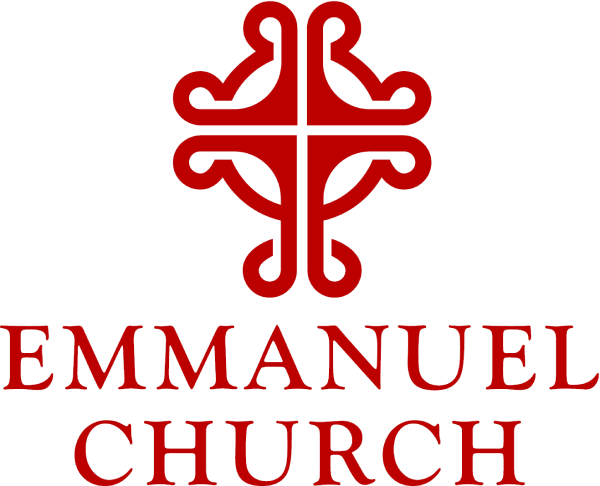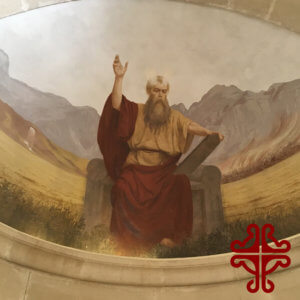
Bright Clouds of Glory
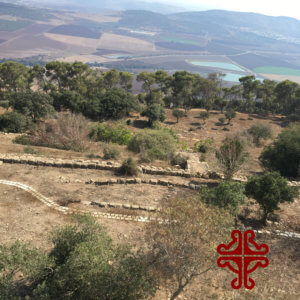 Today we celebrate the Feast of the Transfiguration, when we remember Peter, James, and John’s experience at the top of Mount Tabor, when they climbed up that mountain with Jesus. Mount Tabor is up in the Galilee — a dome-shaped mountain rising from the lowlands like a half sphere — a kind of hump in the land like you’d find on the back of a giant camel. Geologists call it a monadnock. It’s the highest point in the region, and on a clear day, they might have even been able to see the Sea of Galilee out in the distance.
Today we celebrate the Feast of the Transfiguration, when we remember Peter, James, and John’s experience at the top of Mount Tabor, when they climbed up that mountain with Jesus. Mount Tabor is up in the Galilee — a dome-shaped mountain rising from the lowlands like a half sphere — a kind of hump in the land like you’d find on the back of a giant camel. Geologists call it a monadnock. It’s the highest point in the region, and on a clear day, they might have even been able to see the Sea of Galilee out in the distance.
It’s easy to wonder what Jesus planned that day on the mountaintop. We don’t know why they made the climb that day. Maybe they did it to get up high and see out over the Jezreel Valley. Maybe they were remembering where they’d been — trying to see Nazareth, where Jesus grew up.
Or maybe they were trying to see their path through the Arbel pass to Magdala on the way to Peter’s home town of Capernaum, right at the edge of the Sea of Galilee. Jesus preached and taught there. Maybe they were pointing out Cana, up in the hills near Nazareth, where Jesus and Mary had attended a wedding together. Jesus turned water into wine at the wedding feast when supplies ran dry — his first miracle.
You know what it’s like when you get to a high place — a big building in a city, a bell tower in a church, or the crest of the Pell Bridge — you want to look down and see if you can see things you know. Your neighborhood, your old house, your school. The ordinary, mundane things that make up our lives and experience. You want to know what they look like from that vantage point.
What Happens Next?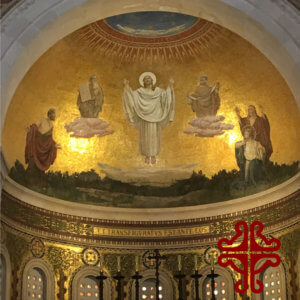
Or maybe Jesus, Peter, James, and John were trying to get a clear view of where they were going and what would happen next. At this point in Matthew’s gospel, Jesus has told the disciples what is going to happen next in his story — that the Son of Man will be crucified and rise from the dead.
And even though he’ll tell them two times more before they ever leave the Galilee to follow the Jordan River Valley up to Jerusalem for Jesus’ final week, they still don’t believe him. These days, pilgrims and tourists climb Mount Tabor, also known as the Mount of Transfiguration, in two or three 18-person vans driven up and down all day by the Palestinian family that owns the restaurant and shop at the base of the camel’s-hump mountain.
It’s a steep climb on a very narrow road, with switchbacks every few minutes, so no matter which side of the van you sit on, you feel like if you lean too far over, the whole van will tumble off the side of the mountain. Some people make it a religious commitment to climb the mountain on foot, like Jesus, Peter, James, and John would have done. Others are more committed to fitness. There’s one guy I saw over and over again last year whose training regimen was to ride his bicycle up and down the mountain twice a day.
There’s a beautiful park at the top, where local people picnic and spend the day outside. On a clear day, you can see for miles from the top of the mountain. But as it turned out, whatever the reason Jesus, Peter, James, and John headed up to the top that day, they didn’t end up looking out at the valley below them, to see where they had been and where they planned to go next.
Instead, they looked up — they looked up at the story of their relationship with God up to that moment and into their eternal future. Suddenly, they saw Jesus, his face shining like the sun, and his clothes a dazzling white, glowing in the company of Moses and Elijah, talking with them. Then a bright cloud surrounded the top of the mountain and God spoke to them, saying This is my son, my beloved; with him I am well-pleased. Peter’s response is immediate: Whoa, Jesus! We’ll stay up here on the mountain with you. We’ll build a house for you here — and also one each for your buds Moses and Elijah!
Cloud of Glory
This is another example of Peter’s overabundant enthusiasm, but there’s also deep background here. Jesus and his disciples were good Jews. They knew their scripture. Remember our Old Testament reading this morning, with Moses up on Mount Sinai in God’s cloud of glory for 40 days and nights, receiving the law.
That cloud of glory on Mount Sinai was so memorable that it comes up again in our psalm this morning:
Moses and Aaron among his priests,
7 He spoke to them out of the pillar of cloud; *
they kept his testimonies and the decree that he gave them.
9 Proclaim the greatness of the Lord our God
and worship him upon his holy hill; *
Does God’s bright cloud on the Mount of Transfiguration that spoke love for Jesus trigger the disciples’ scriptural memory of God’s cloud of glory on Mount Sinai?
And is there anything in the story of God’s cloud of glory on Mount Sinai that could explain Peter’s sudden impulse to build holy housing? We didn’t read that part this morning, but in the very next chapter of Exodus after this morning’s Old Testament reading, God tells Moses from the cloud of glory on Mount Sinai to have the people build him a house: Then have them make a sanctuary for me, and I will dwell among them. 9 Make this tabernacle and all its furnishings exactly like the pattern I will show you, God says. We’re supposed to be thinking about Moses, God’s cloud of glory on Mount Sinai, and the Ten Commandments when we hear about Jesus’ transfiguration. As preacher John Vest writes, on Mount Sinai God’s word is given to the people in the form of the law; in the transfiguration, Christ is revealed as the embodiment of God’s word.
Peter, in offering to build a holy housing complex for Jesus, Moses, and Elijah, is doing exactly what God asked of Moses and the people in Exodus, which means Peter was grounded in the Hebrew Bible and knew exactly what to do when a cloud of glory shows up. And I get Peter’s impulse. What a stunning moment that must have been! Today’s epistle is an almost breathless description of the disciples’ excitement:
but we had been eyewitnesses of his majesty. For he received honor and glory from God the Father when that voice was conveyed to him by the Majestic Glory [that’s that cloud!], saying, “This is my Son, my Beloved, with whom I am well pleased.” We ourselves heard this voice come from heaven, while we were with him on the holy mountain.
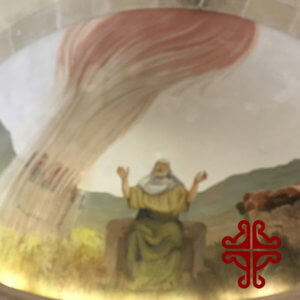
So Peter’s excitement is understandable. He has just seen Jesus — the same Jesus he walked the whole way up the mountain with — his face shining like the sun, with his clothes a dazzling white, deep in conversation with Moses and Elijah. Of course he wanted to memorialize it — to build a house for each of them, to stay there, and make the experience last. But instead Jesus gathers up the disciples and says it’s time to go back down the mountain and get to work.
Preacher Elizabeth Palmer writes, What a strange kind of glory this is: a divine power that refuses to hover above the earth in glorified form but instead climbs back down the mountain and walks straight toward crucifixion, one dusty foot in front of the other. What does this mean for us today? It means that there’s potential in the most ordinary places for transformation. It means that grace comes to us in mundane form — bread, wine, water, the stranger, a narrow road of switchbacks, and pairs of dusty feet. The promise of transfiguration is that the glory of God transforms our world—and us—from the inside out. Today is the last Sunday of Epiphany before Lent, the season when we remember Jesus’ 40 days and nights in the wilderness preparing for his earthly ministry. It’s also the day we remember Peter, James, and John’s experience of Jesus’ transfiguration on the top of Mount Tabor.
Let’s try to stand with Peter, James, and John today as they look out from that high place on the Mount of Transfiguration today. I’m telling you — on a clear day, you can see all the different places we’ve been, all the places we’ve traveled in our life’s experience. But let’s also look — as Peter, James, and John did in today’s gospel — and notice God’s bright cloud of glory. The promise of transfiguration is that the glory of God transforms our world—and us—from the inside out, and from the most mundane elements, in the most ordinary settings.
When we stand on this lookout point of the gospel today, we try to see out from Epiphany into Lent — and to imagine God’s glory transforming ourselves and our world and to prepare for what our own shared ministry will look like next. And from this lookout point today, we can see Ash Wednesday, just days from now. We’ll remember God’s transforming grace from the most mundane elements with a cross of ashes on our foreheads, know that grace is for all of us. Amen
